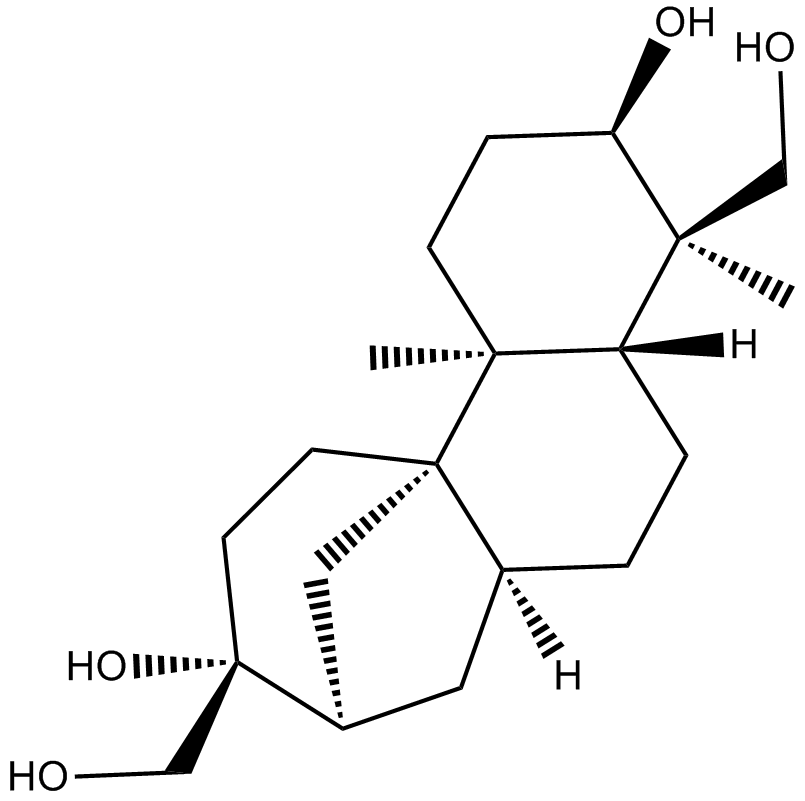(+)-Aphidicolin (Synonyms: ICI 69653, NSC 234714) |
| Catalog No.GC10867 |
Aphidicolin ((+)-Aphidicolin), a reversible inhibitor of eukaryotic nuclear DNA replication, can block the cell cycle at the pre-S phase[1].
Products are for research use only. Not for human use. We do not sell to patients.

Cas No.: 38966-21-1
Sample solution is provided at 25 µL, 10mM.
Aphidicolin ((+)-Aphidicolin), a reversible inhibitor of eukaryotic nuclear DNA replication, can block the cell cycle at the pre-S phase[1]. The minimal concentration of aphidicolin required to produce reversible inhibition of DNA replication without toxic effects in embryos to be 0.5 µM[2].
In vitro experiment it shown that treatment with APC (Aphidicolin) at 6 μM in PBMC cell did not impact baseline DNA damage but could reliably block DNA repair after H2O2 challenge in both fresh and cryopreserved samples[3]. In vitro, treatment with 20 μM aphidicolin for 24 h in bovine aortic ECs (BAECs) reduced BAEC viability by ~40%, which was accompanied by increased NO production, phosphorylation of eNOS at Ser1179 (p-eNOS-Ser1179 were not altered by 1,2-bis (2-aminophenoxy)ethane-N,N,N',N'-tetraacetic acid tetrakis(acetoxymethyl ester) (BAPTA-AM), a cell permeable and specific intracellular Ca2+ chelator[4]. In addition, 5 x 10(-7) M aphidicolin can kill all cells of four human neuroblastoma cell lines as an agent which selectively kills neuroblastoma cells in vitro [5].
In vivo efficacy test it indicated that 4.5 mg aphidicolin/kg body weight was the maximum aphidicolin dose that could be applied as liposomal preparation that tested in neuroblastoma-bearing (UKF-NB-3) mice[6]. Aphidicolin glycinate (has higher solubility agent) (100 mg/kg; i.p.; once every 3 hfor 9 days) showed anti-tumor activity against the implanted B16 melanoma and M5076 sarcoma in murine, producing maximum increased life spans of 75% [7].
References:
[1] Zhang T.Y., et al. Positive effects of treatment of donor cells with aphidicolin on the preimplantation development of somatic cell nuclear transfer embryos in Chinese Bama mini-pig (Sus Scrofa) Anim. Sci. J. 2012;83:103–110.
[2] Navarro-Serna S, et al. Effect of Aphidicolin, a Reversible Inhibitor of Eukaryotic Nuclear DNA Replication, on the Production of Genetically Modified Porcine Embryos by CRISPR/Cas9. Int J Mol Sci. 2022 Feb 15;23(4):2135.
[3] Odongo GA, et al. Optimization of the alkaline comet assay for easy repair capacity quantification of oxidative DNA damage in PBMC from human volunteers using aphidicolin block. DNA Repair (Amst). 2019 May;77:58-64.
[4] Park JH, et al. Nuclear localization of endothelial nitric oxide synthase and nitric oxide production attenuates aphidicolin-induced endothelial cell death. Nitric Oxide. 2021 May 1;109-110:12-19.
[5] Cinatl J, et al. Aphidicolin selectively kills neuroblastoma cells in vitro. Cancer Lett. 1992 Dec 24;67(2-3):199-206.
[6] Michaelis M, et al. Increased systemic efficacy of aphidicolin encapsulated in liposomes. Oncol Rep. 2005 Jan;13(1):157-60.
[7] O'Dwyer PJ, et al. Antitumor activity and biochemical effects of aphidicolin glycinate (NSC 303812) alone and in combination with cisplatin in vivo. Cancer Res. 1994 Feb 1;54(3):724-9.
Average Rating: 5 (Based on Reviews and 3 reference(s) in Google Scholar.)
GLPBIO products are for RESEARCH USE ONLY. Please make sure your review or question is research based.
Required fields are marked with *




















